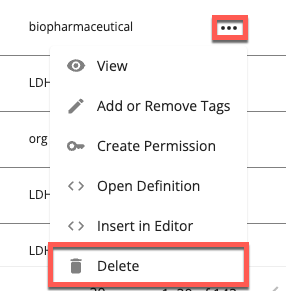Delete an Asset
If your organization owns an asset (tables, views, segments, and user-defined functions (UDFs)), you can delete it. You cannot delete assets that have been shared with you by another organization.
Before deleting an asset, verify that you have not shared it with any partners. You can view and revoke permissions on the Permissions page.
Note
Deleted tables, views, and segments are accessible in the Recycle Bin and can be restored within 30 days of deletion. Deleted assets are permanently deleted from the Recycle Bin after 30 days. For more information, see “The Recycle Bin Page”.
Deleting a table, view, or segment does not delete the corresponding source data.
Any associated data permissions shared with your partners for a table, view, or segment will be revoked and are not restored when the asset is restored. If the asset was shared with partners, you will need to permission the asset again after it is restored.
Deletion of UDFs is permanent and cannot be restored.
Go to the All Assets page, find the asset you want to delete, click its More Options menu (
 ), and select .
), and select .Note
You can also follow the below instructions to delete tables and views while on the Tables and Views page, segments while on the Segments page, and UDFs while on the User-Defined Functions page.

A confirmation message displays.
For tables, views, and segments:
The corresponding source data will not be deleted.
Any associated data permissions shared with your partners for the asset will be revoked.
The asset can be restored for the next 30 days from Administration → Recycle Bin. If the asset was shared with partners, you will need to permission the asset again after it is restored.
You can select the check box in the confirmation message to delete child assets.
For UDFs:
Any associated data permissions shared with your partners for the UDF will be permanently revoked.
Deletion of UDFs is permanent and cannot be restored.
Click .
Tip
You can also delete a function directly from SQL Editor by entering the following and then clicking :
DROP FUNCTION function_name Where: function_name is the name of the function you want to delete.